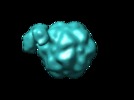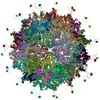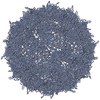[English] 日本語
 Yorodumi
Yorodumi- EMDB-1287: Asymmetric binding of transferrin receptor to parvovirus capsids. -
+ Open data
Open data
- Basic information
Basic information
| Entry | Database: EMDB / ID: EMD-1287 | |||||||||
|---|---|---|---|---|---|---|---|---|---|---|
| Title | Asymmetric binding of transferrin receptor to parvovirus capsids. | |||||||||
 Map data Map data | the map is multiplied by 1.6 to bring it to the scale of the complexed virus map (EMD-1288) | |||||||||
 Sample Sample |
| |||||||||
| Biological species |  Canine parvovirus Canine parvovirus | |||||||||
| Method | single particle reconstruction / cryo EM | |||||||||
 Authors Authors | Hafenstein S / Palermo LM / Xiao C / Kostyuchenko VA / Morais M / Nelson CDS / Chipman PR / Bowman VD / Battisti AJ / Parrish CR / Rossmann MG | |||||||||
 Citation Citation |  Journal: Proc Natl Acad Sci U S A / Year: 2007 Journal: Proc Natl Acad Sci U S A / Year: 2007Title: Asymmetric binding of transferrin receptor to parvovirus capsids. Authors: Susan Hafenstein / Laura M Palermo / Victor A Kostyuchenko / Chuan Xiao / Marc C Morais / Christian D S Nelson / Valorie D Bowman / Anthony J Battisti / Paul R Chipman / Colin R Parrish / Michael G Rossmann /  Abstract: Although many viruses are icosahedral when they initially bind to one or more receptor molecules on the cell surface, such an interaction is asymmetric, probably causing a breakdown in the symmetry ...Although many viruses are icosahedral when they initially bind to one or more receptor molecules on the cell surface, such an interaction is asymmetric, probably causing a breakdown in the symmetry and conformation of the original infecting virion in preparation for membrane penetration and release of the viral genome. Cryoelectron microscopy and biochemical analyses show that transferrin receptor, the cellular receptor for canine parvovirus, can bind to only one or a few of the 60 icosahedrally equivalent sites on the virion, indicating that either canine parvovirus has inherent asymmetry or binding of receptor induces asymmetry. The asymmetry of receptor binding to canine parvovirus is reminiscent of the special portal in tailed bacteriophages and some large, icosahedral viruses. Asymmetric interactions of icosahedral viruses with their hosts might be a more common phenomenon than previously thought and may have been obscured by averaging in previous crystallographic and electron microscopic structure determinations. | |||||||||
| History |
|
- Structure visualization
Structure visualization
| Movie |
 Movie viewer Movie viewer |
|---|---|
| Structure viewer | EM map:  SurfView SurfView Molmil Molmil Jmol/JSmol Jmol/JSmol |
| Supplemental images |
- Downloads & links
Downloads & links
-EMDB archive
| Map data |  emd_1287.map.gz emd_1287.map.gz | 9.9 MB |  EMDB map data format EMDB map data format | |
|---|---|---|---|---|
| Header (meta data) |  emd-1287-v30.xml emd-1287-v30.xml emd-1287.xml emd-1287.xml | 9.5 KB 9.5 KB | Display Display |  EMDB header EMDB header |
| Images |  1287.gif 1287.gif | 17.6 KB | ||
| Archive directory |  http://ftp.pdbj.org/pub/emdb/structures/EMD-1287 http://ftp.pdbj.org/pub/emdb/structures/EMD-1287 ftp://ftp.pdbj.org/pub/emdb/structures/EMD-1287 ftp://ftp.pdbj.org/pub/emdb/structures/EMD-1287 | HTTPS FTP |
-Validation report
| Summary document |  emd_1287_validation.pdf.gz emd_1287_validation.pdf.gz | 210.4 KB | Display |  EMDB validaton report EMDB validaton report |
|---|---|---|---|---|
| Full document |  emd_1287_full_validation.pdf.gz emd_1287_full_validation.pdf.gz | 209.5 KB | Display | |
| Data in XML |  emd_1287_validation.xml.gz emd_1287_validation.xml.gz | 5.9 KB | Display | |
| Arichive directory |  https://ftp.pdbj.org/pub/emdb/validation_reports/EMD-1287 https://ftp.pdbj.org/pub/emdb/validation_reports/EMD-1287 ftp://ftp.pdbj.org/pub/emdb/validation_reports/EMD-1287 ftp://ftp.pdbj.org/pub/emdb/validation_reports/EMD-1287 | HTTPS FTP |
-Related structure data
- Links
Links
| EMDB pages |  EMDB (EBI/PDBe) / EMDB (EBI/PDBe) /  EMDataResource EMDataResource |
|---|
- Map
Map
| File |  Download / File: emd_1287.map.gz / Format: CCP4 / Size: 13.1 MB / Type: IMAGE STORED AS FLOATING POINT NUMBER (4 BYTES) Download / File: emd_1287.map.gz / Format: CCP4 / Size: 13.1 MB / Type: IMAGE STORED AS FLOATING POINT NUMBER (4 BYTES) | ||||||||||||||||||||||||||||||||||||||||||||||||||||||||||||||||||||
|---|---|---|---|---|---|---|---|---|---|---|---|---|---|---|---|---|---|---|---|---|---|---|---|---|---|---|---|---|---|---|---|---|---|---|---|---|---|---|---|---|---|---|---|---|---|---|---|---|---|---|---|---|---|---|---|---|---|---|---|---|---|---|---|---|---|---|---|---|---|
| Annotation | the map is multiplied by 1.6 to bring it to the scale of the complexed virus map (EMD-1288) | ||||||||||||||||||||||||||||||||||||||||||||||||||||||||||||||||||||
| Projections & slices | Image control
Images are generated by Spider. | ||||||||||||||||||||||||||||||||||||||||||||||||||||||||||||||||||||
| Voxel size | X=Y=Z: 3.42 Å | ||||||||||||||||||||||||||||||||||||||||||||||||||||||||||||||||||||
| Density |
| ||||||||||||||||||||||||||||||||||||||||||||||||||||||||||||||||||||
| Symmetry | Space group: 1 | ||||||||||||||||||||||||||||||||||||||||||||||||||||||||||||||||||||
| Details | EMDB XML:
CCP4 map header:
| ||||||||||||||||||||||||||||||||||||||||||||||||||||||||||||||||||||
-Supplemental data
- Sample components
Sample components
-Entire : empty canine parvovirus particles
| Entire | Name: empty canine parvovirus particles |
|---|---|
| Components |
|
-Supramolecule #1000: empty canine parvovirus particles
| Supramolecule | Name: empty canine parvovirus particles / type: sample / ID: 1000 / Oligomeric state: icosahedral virus particles / Number unique components: 1 |
|---|
-Supramolecule #1: Canine parvovirus
| Supramolecule | Name: Canine parvovirus / type: virus / ID: 1 / Name.synonym: CPV / Details: empty virus capsids / NCBI-ID: 10788 / Sci species name: Canine parvovirus / Virus type: VIRION / Virus isolate: STRAIN / Virus enveloped: No / Virus empty: Yes / Syn species name: CPV |
|---|---|
| Host (natural) | synonym: VERTEBRATES |
| Virus shell | Shell ID: 1 / Name: capsid / Diameter: 280 Å / T number (triangulation number): 3 |
-Experimental details
-Structure determination
| Method | cryo EM |
|---|---|
 Processing Processing | single particle reconstruction |
| Aggregation state | particle |
- Sample preparation
Sample preparation
| Buffer | pH: 7.5 / Details: 20mM Tris-HCl |
|---|---|
| Vitrification | Cryogen name: ETHANE |
- Electron microscopy
Electron microscopy
| Microscope | FEI/PHILIPS CM200FEG |
|---|---|
| Temperature | Average: 100 K |
| Date | May 6, 2005 |
| Image recording | Category: FILM / Film or detector model: KODAK SO-163 FILM / Digitization - Scanner: ZEISS SCAI / Digitization - Sampling interval: 14 µm / Number real images: 3 / Average electron dose: 18 e/Å2 Details: images were scanned at 7 micron sampling step size followed by 2x2 averaging to produce 14 micron step size Bits/pixel: 8 |
| Electron beam | Acceleration voltage: 200 kV / Electron source:  FIELD EMISSION GUN FIELD EMISSION GUN |
| Electron optics | Illumination mode: FLOOD BEAM / Imaging mode: BRIGHT FIELD / Cs: 2 mm / Nominal defocus max: 3.5 µm / Nominal defocus min: 2.0 µm / Nominal magnification: 38000 |
| Sample stage | Specimen holder: 626 Single Tilt Cryotransfer System / Specimen holder model: GATAN LIQUID NITROGEN |
- Image processing
Image processing
| CTF correction | Details: CTF correction of each particle |
|---|---|
| Final reconstruction | Applied symmetry - Point group: I (icosahedral) / Algorithm: OTHER / Software - Name: XMIPP with modifications Details: Intermediate reconstructions were made from images with virus density subtracted, final reconstruction was calculated from complete images. Number images used: 2027 |
| Final angle assignment | Details: initial angles were selected using SPIDER VO EA procedure with limits for theta of 0-40, phi of 0-72 to cover an asymmetric unit of an icosahedron; During orientation search the angles were ...Details: initial angles were selected using SPIDER VO EA procedure with limits for theta of 0-40, phi of 0-72 to cover an asymmetric unit of an icosahedron; During orientation search the angles were changed to be one of the 60 icosahedral symmetry equivalent triplet. |
| Final two d classification | Number classes: 226 |
 Movie
Movie Controller
Controller









 Z (Sec.)
Z (Sec.) Y (Row.)
Y (Row.) X (Col.)
X (Col.)





















